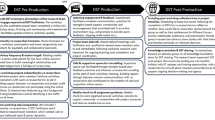Abstract
Larsson, an experienced research journalist, shares her experience of producing digital stories for research dissemination on behalf of researchers. The purpose is to investigate the merits and challenges of a personal multimodal story approach, in a context where a professional produces the final product. Based on interviews with the storytelling researchers the author identifies qualities and issues. Digital stories capture the driving force behind the research, are sustainable and reach a larger audience thereby opening new opportunities. Researchers are unused to be in focus as a person and some fear the personalized research communication is less trustworthy in an academic context. Larsson concludes that digital storytelling is a valid addition to research dissemination.
Access this chapter
Tax calculation will be finalised at checkout
Purchases are for personal use only
Similar content being viewed by others
References
Barker Ruchti, N. (2015, August). E-mail exchange between the author and Nathalie Barker Ruchti.
Boyd, B. (2009). The origins of story evolution cognition and fiction. Cambridge, MA: Harvard University Press.
Boyer, E. (1990). Scholarship reconsidered: Priorities of the professoriate. Princeton: The Carnegie Foundation for the Advancement of Teaching.
Bucchi, M., & Trench, B. (2008). Handbook of public communication of science and technology. London/New York: Routledge.
Bultitude, K. (2011). The why and how of science communication. In P. Rosulek (Ed.), Science communication. Pilsen: European Commission.
Burgess, J. (2006). Hearing ordinary voices: Cultural studies, vemacular creativity and digital storytelling. Continuum Journal of Media and Cultural Studies, 20(2), 201–214.
Dacke, M. (2015, August). Telephone interview between the author and Marie Dacke.
Dmitrijev, A. (2015, September). E-mail exchange between the author and Alexander Dmitrijev.
Gottschall, J. (2012). The storytelling animal, how stories make us human. Boston: Houghton Mifflin Harcourt.
Hartley, J., & McWilliam, K. (2009). Storycircle. Digital storytelling around the world. Chichester: Wiley-Blackwell.
Haven, K. (2007). Story proof: The science behind the starling power of story. Westport: Libraries Unlimited.
Lambert, J. (2013). Digital storytelling capturing lives creating community. New York: Routledge.
Lundby, K. (2008). Digital storytelling, mediatized stories: Self-representations in new media. New York: Peter Lang.
Margles, S. (2014). The mahi-mahi & the map: Digital storytelling for science. Cool Green Science. http://blog.nature.org/science/2014/02/18/themahi-mahi-the-map-digital-storytelling-for-science/.
Minke-Martin, V. (2015). Narratives of nature: Use storytelling to reach new audiences with your research. Canadian Science Publishing. http://www.cdnsciencepub.com/blog/narratives-of-nature-use-storytelling-toreach-new-audiences-with-your-research.aspx.
Negrete, A., & Lartigue, C. (2004). Learning from education to communicate science as a good story. Endeavour, 28(3), 120–124.
Olson, R. (2015). Houston, We have a narrative: Why science need story. Chicago: The University of Chicago Press.
Zak, P. (2012). The moral molecule actions. The source of love and prosperity. Dutton: Penguin Group.
Zikovich, B. (2013). Telling science stories. Scientific American.
Author information
Authors and Affiliations
Editor information
Editors and Affiliations
Appendix 1: List of Involved Researchers and Links to the Digital Stories
Appendix 1: List of Involved Researchers and Links to the Digital Stories
Alexander Dmitrijev, Associate Professor, Bionanophotonics, Department of Physics Chalmers. http://www.chalmers.se/sv/forskning/vara-forskare/Sidor/Alexander-Dmitriev.aspx
Natalie Barker Ruchti, Associate Professor, Sport Science, Faculty of Education Gothenburg University. http://iki.gu.se/english
Marie Dacke, Associate Professor, Functional Zoology, Department of Biology Lunds University. https://www.youtube.com/watch?v=LeSgdzMm16c
Caroline Jonsson, Doctor, Nanoparticles, Department of Chemistry & Molecular Biology, Gothenburg University. https://vimeo.com/150806315
Johan Mauritsson, Associate Professor, Atom Physics, Faculty of Engineering, Lunds University. https://www.youtube.com/watch?v=fFNCDX2bqlE
Johan Malmström, Associate Professor, Infection Medicine, Faculty of Medicine, Lunds University. https://www.youtube.com/watch?v=j9sghCazy50
Martin Högbom, Associate Professor, Structural Biochemistry, Department of Biochemistry and Biophysics, Stockholm University. https://www.youtube.com/watch?v=Nmp2mNiawr8
Peter Nilsson, Professor, Chemical Biology, Department of Physics, Chemistry and Biology, Linköping University. https://www.youtube.com/watch?v=_h6GeLOfZt8
Camilla Svensson, Assistant Professor, Molecular Pain Research, Department of Physiology and Pharmacology, Karolinska Institutet. https://www.youtube.com/watch?v=LFmtbxHfDZQ&list=PLAwDfLnMNIOZ4kG0OKmE1fy6ey1bgsU53&index=15
Sebastian Westenhoff, Associate Professor, Membrane Proteins, Department of Chemistry & Molecular Biology, Gothenburg University. https://www.youtube.com/watch?v=cqp7u6NGlww&index=5&list=PLAwDfLnMNIOZ4kG0OKmE1fy6ey1bgsU53
Rickard Sandberg, Associate Professor, Cell and Molecular Biology, Department of Cell and Molecular Biology, Karolinska Institutet. https://www.youtube.com/watch?v=hU_DzpK3ZMw&index=6&list=PLAwDfLnMNIOZ4kG0OKmE1fy6ey1bgsU53
Rights and permissions
Copyright information
© 2017 The Author(s)
About this chapter
Cite this chapter
Larsson, R. (2017). My Story or Your Story? Producing Professional Digital Stories on Behalf of Researchers. In: Jamissen, G., Hardy, P., Nordkvelle, Y., Pleasants, H. (eds) Digital Storytelling in Higher Education. Digital Education and Learning. Palgrave Macmillan, Cham. https://doi.org/10.1007/978-3-319-51058-3_12
Download citation
DOI: https://doi.org/10.1007/978-3-319-51058-3_12
Published:
Publisher Name: Palgrave Macmillan, Cham
Print ISBN: 978-3-319-51057-6
Online ISBN: 978-3-319-51058-3
eBook Packages: EducationEducation (R0)




